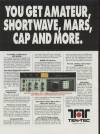Paragon II Model 586
Description
All solid state microprocessor controlled HF transceiver covering all amateur bands on transmit and general coverage receive from 100 kHz to 29.999 MHZ.
Reviews
Mods & Tips
Accessories
Some Basic Differences Between Paragon Model 585 and Paragon II Model 586
- Paragon II 586 includes both AM and FM transmit and receive, the Paragon 585 needs an additional FM board to run FM transmit.
- The Paragon 585 will receive AM but not transmit AM. The Paragon II 586 will both transmit and receive on AM. The 586 AM transmit signal is carrier plus single side band (selectable), it does NOT transmit carrier plus double side band.
- The Paragon II has a Omni VI style front button set with a more advanced logic design circuitry to allow for band stacking registers like the Omni VI.
Difference Between the Paragon II Model 586 and Omni VI Model 563
From the Ten Tec Reflector December 11, 1996
The main difference between the (now discontinued) Paragon II and the Omni-VI is the way the receiver is set up. The Paragon II, like all Japanese rigs, uses a microprocessor synthesizer for frequency generation. The Omni-VI (and Omni-V) use a short range PLL (500 kHz) mixed with crystal local oscillators for each ham band. While the sensitivity and selectivity specs are similar between the two, the Omni-VI has better overall rx performance than the Paragon II. The phase noise performance of the Omni-VI vs. Paragon II is -20db better as well. (Might as well add here that the phase noise performance is significantly better than the Japanese rigs, and our specs for rx sensitivity have yet to be matched, even by the IF-DSP transceivers). The Omni-VI also has the option for crystal filtering in both the 1st and 2nd IF, while the Paragon series is 2nd IF only.
Trade off: No general coverage receiver in the Omni-VI.
The predecessor to the Omni-V and Omni-VI were the Corsair and Corsair II, which used a similar rx scheme, utilizing a PTO rather than the PLL.
73, Scott Robbins W4PA at Ten-Tec
Sales Information
Specifications
Note: These specifications taken from original Paragon Model 585 specs.
General
- Frequency Range: Receive: 100 kHz to 29.999 Mhz. Transmit: Standard Ham Bands 160m - 10m (Note: For operation outside Ham Bands contact factory.).
- Frequency Control: Microprocessor controlled digital PLL synthesizer. 10 Hz resolution.
- Frequency Readout: 7 digit 10 Hz fluorescent readout.
- Frequency Stability: Worst case, 1 PPM per degree C at 29.999 MHz.
- Antenna Impedance: 50 ohm unbalanced.
- Power Required: Receive - approx. 1.5 A. Transmit - approx. 20 A. @ 13.8 VDC.
- Construction: Rigid aluminum chassis. Extruded aluminum front panel. Textured top and bottom, snap up stainless steel bail.
- Dimensions: HWD 5.75" x 14.75" x 17" (14.6 x 37.4 x 43.2 cm)
- Net Weight: 16 lbs (7.25 kg).
Transmitter
- Modes: USB, LSB, CW, AM, FM, RTTY (FSK or AFSK), .
- DC Power Input: Maximum 200 watts @ 14 VDC CW, SSB, (FM). 100% duty cycle for up to 20 minutes. Continuous with auxiliary air cooling.
- RF Power Output: 25 to 100 watts adjustable with front panel RF PWR control.
- Microphone Input: High/Low impedance. Four pin, front panel connector accepts microphones with 5 mV (-62 dB) output. Polarizing voltage is provided for electrets.
- T/R Switching: VOX or PTT on SSB. Switchable FAST or SLOW QSK on CW.
- CW Sidetone: Internally generated, adjustable tone and volume independant of AF GAIN control.
- SSB Generation: 9 MHz, 8-pole crystal ladder filter. Balanced modulator.
- Carrier Suppression: 60 dB typcial.
- Unwanted Sideband Suppression: 60 dB typical at 1.5 kHz tone.
- Spurious Output: More than 45 dB below peak power output.
- Meter: Switchable forward power, SWR, collector current, audio processing level.
- CW Offset: 750 Hz automatic.
- FSK Shift: 170 Hz.
Receiver
- Modes: USB, LSB, CW, FSK/AFSK, AM, FM.
- Sensitivity:
| Mode | Frequency, MHz | ||
|---|---|---|---|
| 0.1 - 1.6 | 1.6 - 29.999 | ||
| SSB, CW, RTTY | 0.5 uV | 0.15 uV | 10 dB S/N @ 2.4 kHz |
| AM | 3.5 uV | 1.00 uV | 10 dB S/N @ 6.0 kHz |
| FM | 1.00 uV | 0.30 uV | 12 dB SINAD @ 15 kHz |
- Selectivity:
| Filter | Selectivity | |
|---|---|---|
| -6 dB | -60 dB | |
| Standard | 2.40 kHz | 3.36 kHz |
| AM | 6.00 kHz | 11.25 kHz |
| Optional | 1.80 kHz | 2.90 kHz |
| Optional | .50 kHz | 1.40 kHz |
| Optional | .25 kHz | .85 kHz |
| FM | 15 kHz | 30 kHz |
- Attenuator: Approx. -20 dB for 1.6 to 29.999 MHz, -10 dB for 0.1 to 1.6 MHz.
- I-F Frequencies: 1st - 75 MHz, 2nd - 9.0 MHz, 3rd - 6.3 MHz (FM 3rd - 455 kHz).
- RX Antenna Input: Switchable 50 ohm phono jack.
- Image Rejection: >80 dB.
- I-F Rejection: >70 dB.
- Noise Blanker: Switchable on/off with adjustable width.
- S-Meter: Automatically switched on during receive. Calibrated to 50 uV at S9.
- Dynamic Range: 100 dB typical.
- 3rd Order ICP: +18 dBm.
- Squelch Sensitivity: AM, CW, SSB, FSK (1.6 - 29.999 MHz) - Less than 1 uV. FM (1.6 - 29.999 MHz) - Less than 0.4 uV.
- Pass Band Tuning: +/- 1.2 kHz.
- Audio Output: 1.5 watts @ 8 ohm with less than 2% distortion.
- Notch Filter: 250 to 2.2 kHz, 50 dB notch typical.
- Audio Bnadpass Filter: 4 pole, variable center frequency 220 to 1.7 kHz, 35% bandwidth @ -6 dB. Variable fader control selects filtered or flat audio response.
- Tone Control: Variable 15 dB rolloff @ 5 kHz.

